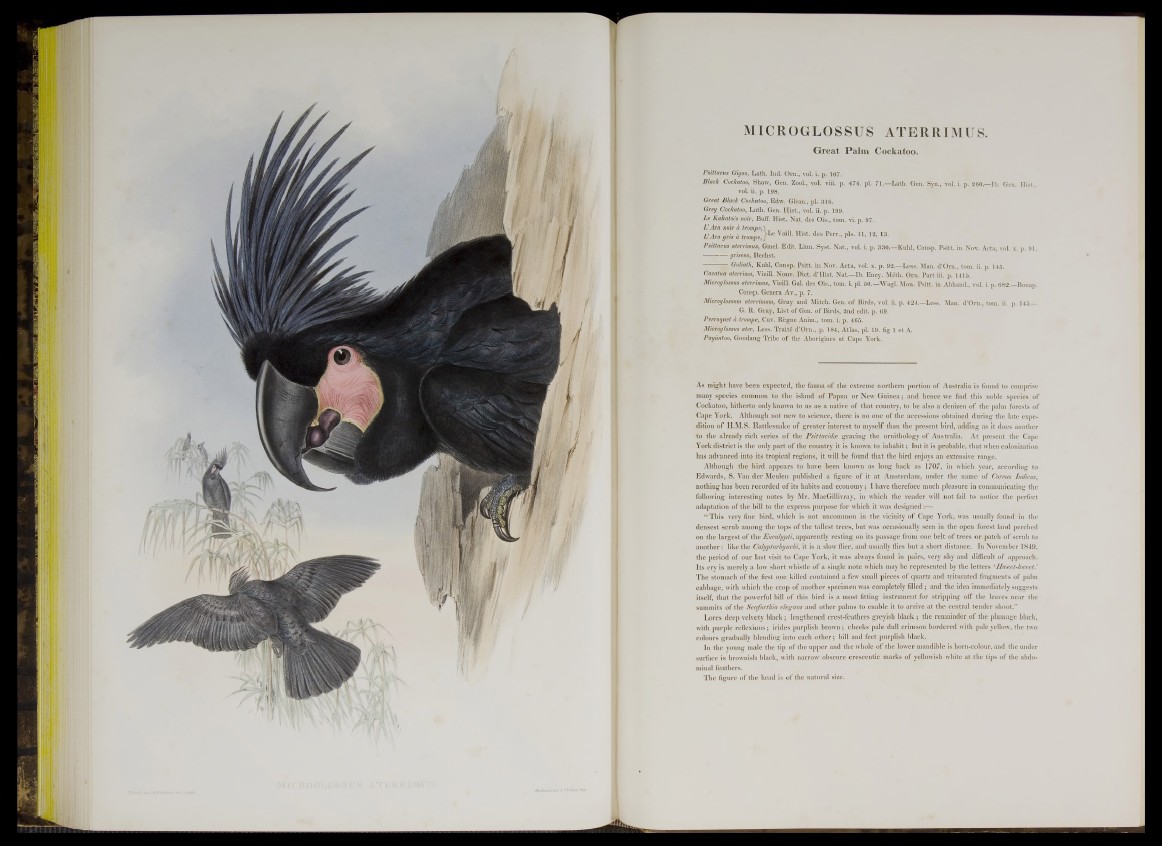
MICROGLOSSUS ATERRIMUS.
Great Palm Cockatoo.
Psittacus Gigas, Lath. Ind. Qrn., vol. i. p. 107.
Black Cockatoo, Shaw, Gen. Zool, vol. viii. p. 474. pi. 71.—Lath. Gen. Syn., vol. i. p. 260.—Ib. Gen. Hist.,
vol. ii. p. 198.
Great Black Cockatoo, Edw. Glean., pi. 316.
Grey Cockatoo, Lath. Gen. Hist., vol. ii. p. 199.
Le Kakatoès noir, Buff. Hist. Nat. des Ois., tom. vi. p. 97.
V Ara noir à trompe,'i
L'Ara gris à trempe, ƒ Le VaUL Hist' des Pen'> Pla- 13-
Psittacus aterrimus, Gmel. Edit. Linn. Syst. Nat., toL i. p. 330.—KuW, Consp. Psitt, in Not. Acta, vol. x. p. 91.
---------- griseus, Bechst.
— Goliath, Kuhl, Consp. Psitt, in Nov. Acta, vol. x. p. 92.—Less. Man. d’Orn., tom. ii. p. 145.
Cacatua aterrima, Vieill. Nouv. Diet. d’Hist. Nat.—Ib. Ency. Méth. Ora. Part iii. p. 14 15 .
Microglossm aterrimus, Vieill. Gai. des Ois., tom. i. pl. 50.—Wagl. Mon. Psitt, in Abhand., vol. i. p. 682.—Bonap.
Consp. Genera Av., p. 7.
Microglossum aterrimum, Gray and Mitch. Gen. of Birds, vol. ii. p. 424.—Less. Man. d’Orn., tom. ii. p. 145.—
G. R. Gray, List of Gen. of Birds, 2nd edit. p. 69.
Perroquet à trompe, Cuv. Règne Anim., tom. i. p. 465.
Microglossus ater, Less. Traité d’Om., p. 184, Atlas, pl. 19. fig 1 et A.
Payantoo, Goodang Tribe of the Aborigines at Cape York.
As might have been expected, the fauna of the extreme northern portion of Australia is found to comprise
many species common to the island of Papua or New Guinea; and hence we find this noble species of
Cockatoo, hitherto only known to us as a native of that country, to be also a denizen of the palm forests of
Cape York. Although not new to science, there is no one of the accessions obtained during the late expedition
of H.M.S. Rattlesnake of greater interest to myself than the present bird, adding as it does another
to the already rich series of the Psittacidce gracing the ornithology of Australia. At present the Cape
York district is the only part of the country it is known to inhabit; but it is probable, that when colonization
has advanced into its tropical regions, it will be found that the bird enjoys an extensive range.
Although the bird appears to have been known as long back as 1707, in which year, according to
Edwards, S. Van der Meulen published a figure of it at Amsterdam, under the name of Corcus Indicus,
nothing has been recorded of its habits and economy; I have therefore much pleasure in communicating the
following interesting notes by Mr. MacGillivray, in which the reader will not fail to notice the perfect
adaptation of the bill to the express purpose for which it was designed:—
“ This very fine bird, which is not uncommon in the vicinity of Cape York, was usually found in the
densest scrub among the tops of the tallest trees, but was occasionally seen in the open forest land perched
on the largest of the Eucalypti, apparently resting on its passage from one belt of trees or patch of scrub to
another: like the Calyptorhynchi, it is a slow flier, and usually flies but a short distance. In November 1849,
the period of our last visit to Cape York, it was always found in pairs, very shy and difficult of approach.
Its cry is merely a low short whistle of a single note which may be represented by the letters *Hweet-hweet'
The stomach of the first one killed contained a few small pieces of quartz and triturated fragments of palm
cabbage, with which the crop of another specimeu was completely filled ; and the idea immediately suggests
itself, that the powerful bill of this bird is a most fitting instrument for stripping off the leaves near the
summits of the Seaforthia elegans and other palms to enable it to arrive at the central tender shoot.”
Lores deep velvety black; lengthened crest-feathers greyish black ; the remainder of the plumage black,
with purple reflexions; irides purplish brown; cheeks pale dull crimson bordered with pale yellow, the two
colours gradually blending into each o th e r; bill and feet purplish black.
In the young male the tip of the upper and the whole of the lower mandible is horn-colour, and the under
surface is brownish black, with narrow obscure crescentic marks of yellowish white at the tips of the abdominal
feathers.
The figure of the head is of the natural size.